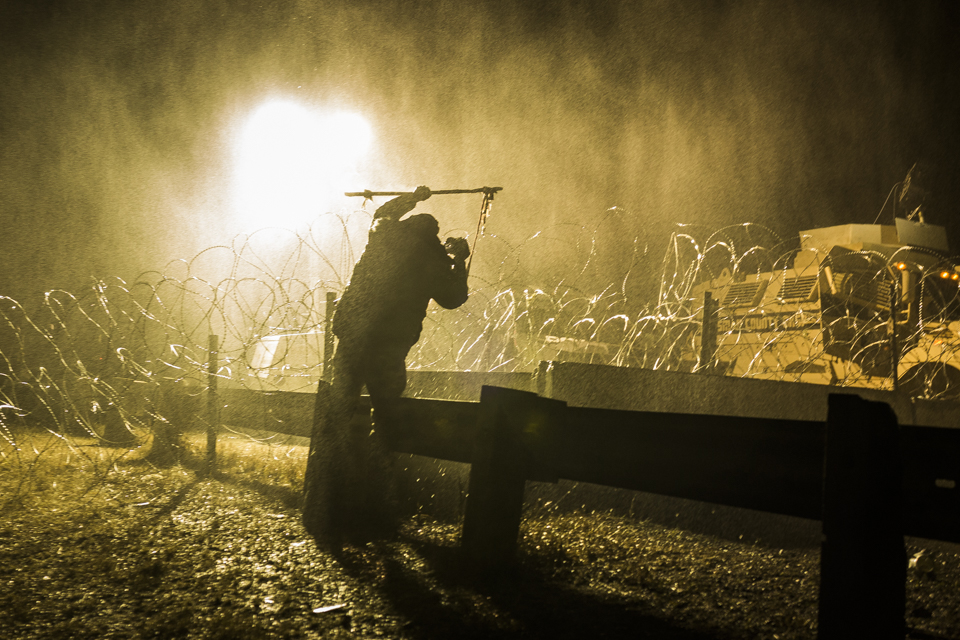
by Deep Green Resistance News Service | Nov 21, 2016 | Obstruction & Occupation, Repression at Home
by Indigenous Environmental Network
Cannon Ball – On November 20th at approximately 6PM CST over 100 Water Protectors from the Oceti Sakowin and Sacred Stone Camps mobilized to a nearby bridge to remove a barricade that was built by the Morton County Sheriff’s Department and the State of North Dakota. This barricade, built after law enforcement raided the 1851 treaty camp, not only restricts North Dakota residents from using the 1806 freely but also puts the community of Cannon Ball, the camps, and the Standing Rock Tribe at risk as emergency services are unable to use that highway.
Water Protectors used a semi-truck to remove two burnt military trucks from the road and were successful at removing one truck from the bridge before police began to attack Water Protectors with tear gas, water canons, mace, rubber bullets, and sound cannons.
At 1:30am CST the Indigenous Rising Media team acquired an update from the Oceti Sakowin Medic team that nearly 200 people were injured, 12 people were hospitalized for head injuries, and one elder went into cardiac arrest at the front lines. At this time, law enforcement was still firing rubber bullets and the water cannon at Water Protectors. About 500 Water protectors gathered at the peak of the non-violent direct action.
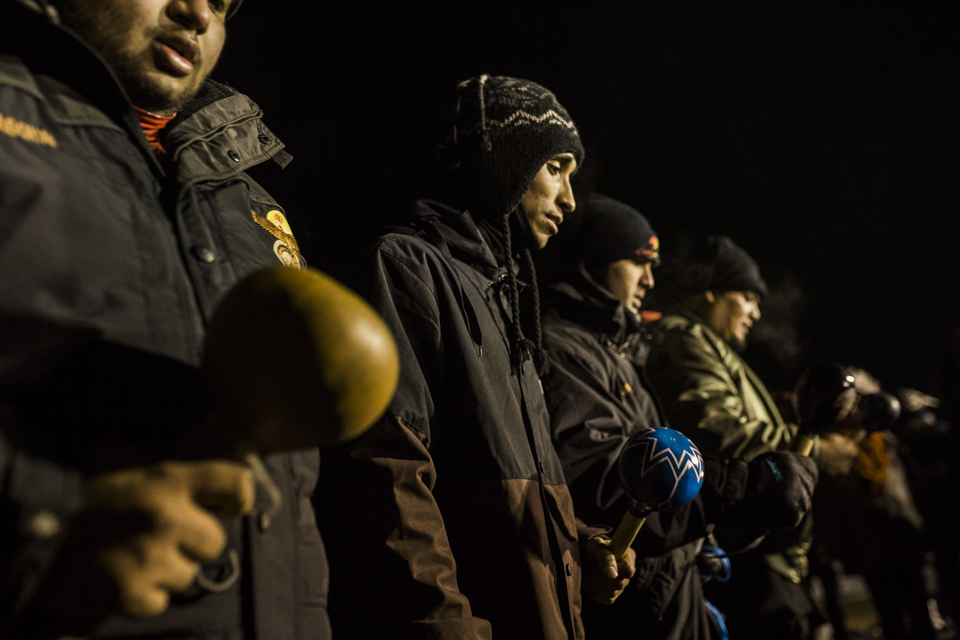
The following is a statement from the Indigenous Environmental Network:
“The North Dakota law enforcement are cowards. Those who are hired to protect citizens attacked peaceful water protectors with water cannons in freezing temperatures and targeted their weapons at people’s faces and heads.
“The Morton County Sheriff’s Department, the North Dakota State Patrol, and the Governor of North Dakota are committing crimes against humanity. They are accomplices with the Dakota Access Pipeline LLC and its parent company Energy Transfer Partners in a conspiracy to protect the corporation’s illegal activities.
“Anyone investing and bankrolling these companies are accomplices. If President Obama does nothing to stop this inhumane treatment of this country’s original inhabitants, he will become an accomplice. And there is no doubt that President Elect Donald Trump is already an accomplice as he is invested in DAPL”.
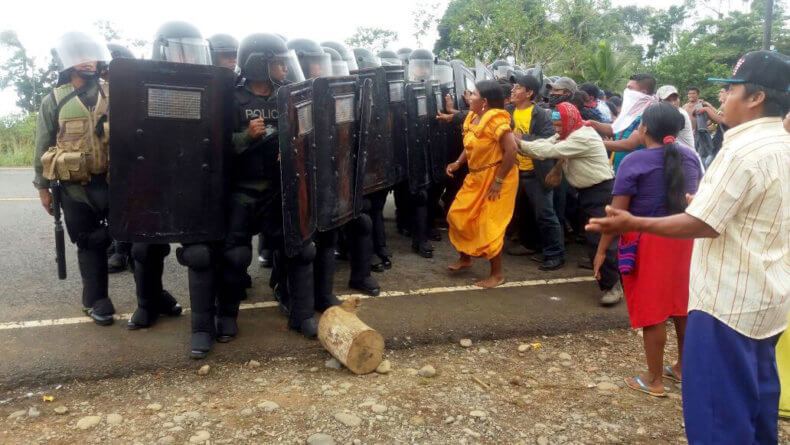
by Deep Green Resistance News Service | Sep 5, 2016 | Colonialism & Conquest
Featured Image: Police clashes. Credit: Frenadeso
By Richard Arghiris / Intercontinental Cry
Panama’s national police left approximately 20 indigenous Ngäbe protesters injured last week in what one medic described as an “absurd and irresponsible act.”
The protesters, all residents of Gualaquita, mobilized against the Barro Blanco hydro dam after the project’s owner and operator, Honduran-based Generadora del Istmo (GENISA) began flooding the Tabasará River basin with blessings from the government.
It didn’t take long for Ngäbe communities within the basin to suffer the consequences. In the community of Kiad, local road connections were washed away by the flood waters leaving entire families geographically isolated. Houses were also submerged by the rising waters, along with significant archaeological sites in the region.
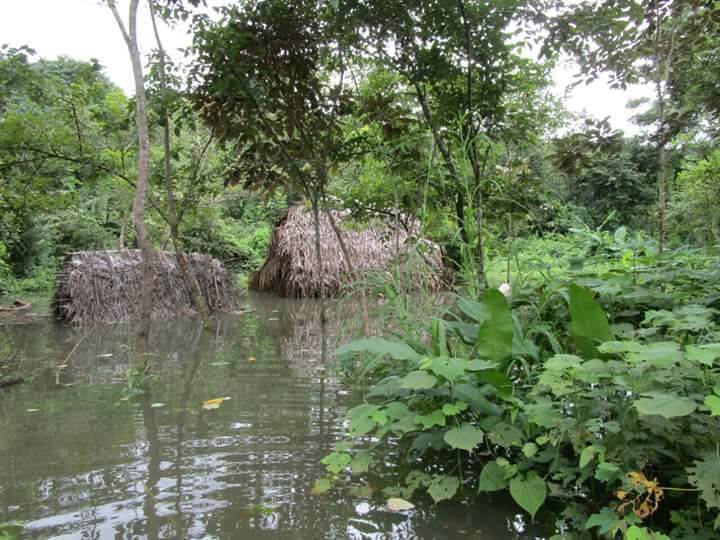
Submerged houses. Photo: Ricardo Miranda
All of the Tabasará communities affected by the flood waters were excluded from the talks that led to the agreement. They also didn’t endorse the new agreement in any way, shape, or form.
The Ngäbe community of Gualaquita is located outside of the affected area, but they too declined to endorse the agreement.
For the protesters, who are members of the Mama Tatda religion, the Tabasará River is a holy site that needs to be protected. The river is also home to ancient petroglyphs and unique Ngäbe cultural centers. To the protesters, their loss or destruction represents a violation of religious freedom.
The government wasted little time responding to the protesters.
According to a preliminary report by one of the country’s largest trade unions – the National Front for the Defense of Economic and Social Rights (Frenadeso) – around 2pm on Aug 24, 2016, some 500 police officers arrived to crush the opposition.
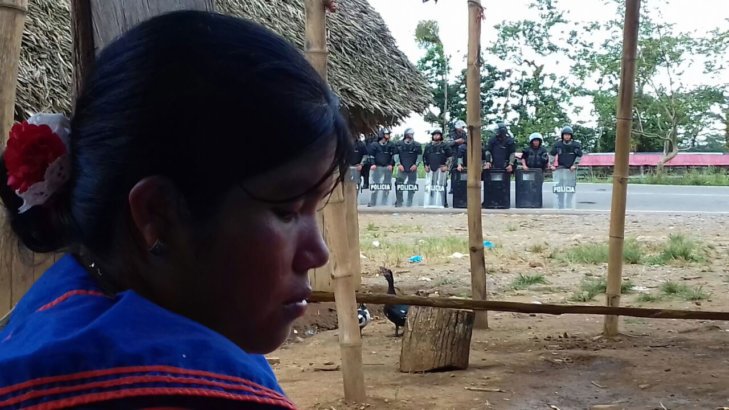
Police in Gualaquita. Credit: Frenadeso
Speaking to Frenadeso, Dr. Manuel Pardo, who attended to the injured in the aftermath of the assault, called the protesters “victims of police aggression,” stating, “There was a clear and flagrant violation of the fundamental human rights of the community of Gualaquita.”
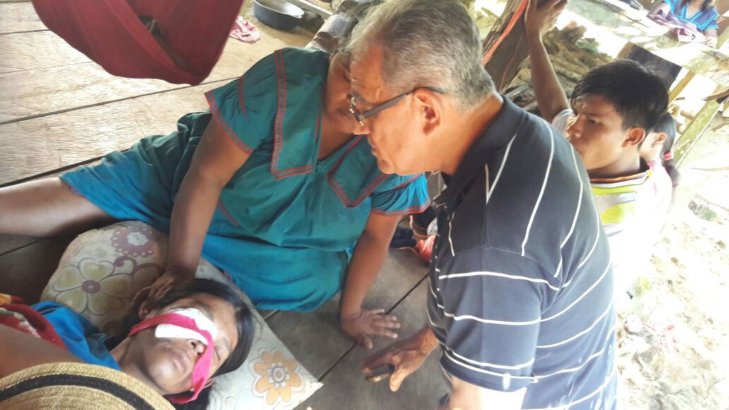
Dr. Manuel Pardo assesses the injured. Credit: Frenadeso
Osvaldo Jordan, director of the Alliance for Conservation and Development (ACD), told IC that the police didn’t just target the protesters. “[They] stormed into the whole community, detaining people who were not even in the protest… It was an outright occupation of the community, war style.”

Injuries that appear to have been inflicted by rubber bullets. Credit: Frenadeso
“The weapons that were used for the confrontation were rubber bullets, birdshot and pepper gas,” said Dr. Pardo during his visit to the community on Aug 28, 2016.
“The police entered the community and practically every house was ‘fumigated’ with pepper gas… we are still coughing and itchy… In addition to rubber bullets, birdshot and pepper gas, the attacks involved physical blows and kicking… The result was 20 people injured…”
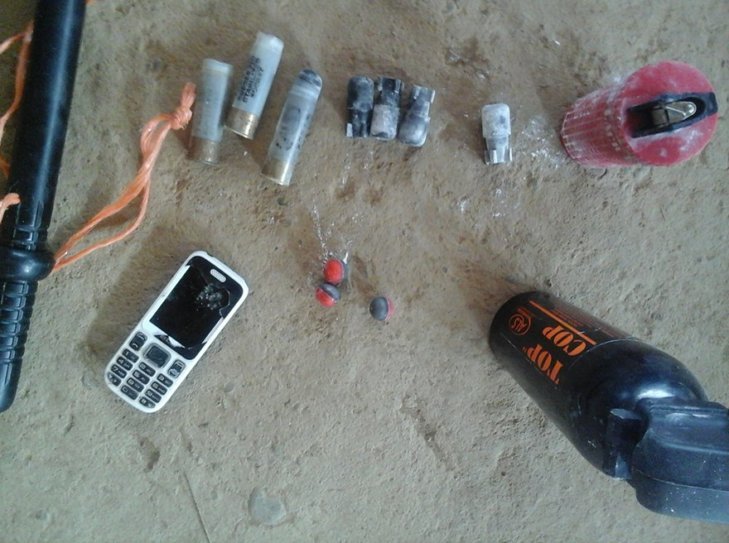
Police ammunition and equipment collected in Gualaquita. Credit: unknown

Police ammunition and equipment collected in Gualaquita. Credit: unknown

Police ammunition and equipment collected in Gualaquita. Credit: unknown
Dr. Pardo went on to explain that, three of the protesters were severely wounded during the crackdown. One person may have suffered a life-changing injury to his right eye. Another, who sustained serious head trauma, was detained by police for 48 hours before receiving medical treatment in a hospital.
Some of the injured community members reportedly refused to seek help from official institutions for fear of being arrested. Dr. Pardo described this as a “lamentable” violation of their basic human right to health care.
The Frenadeso report also alleges that the police burned a Mama Tatda flag and broke into several community stores. They apparently stole food, cell phones, chargers and hundreds of dollars in cash. They are also alleged to have threatened a storekeeper with firearms and made various death threats to different people.
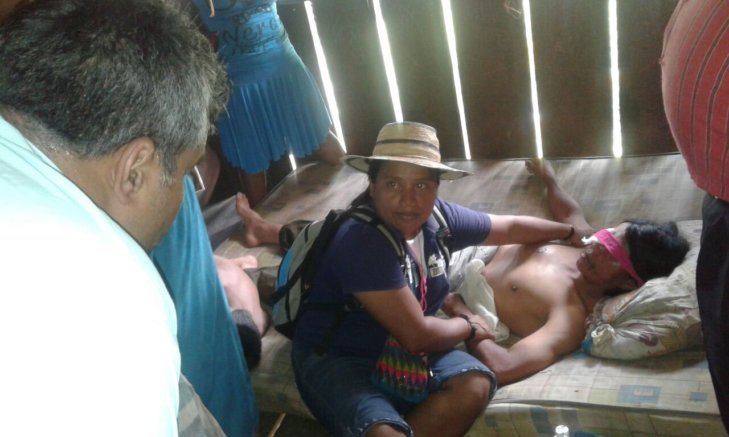
Adolfo Miranda was allegedly shot in his right eye by a rubber bullet. Credit: Frenadeso
Some of the protesters hit back at the police with rocks and slingshots. Several officers were injured and subsequently transported by plane for treatment in private hospitals.
In the aftermath of the clash, images of the injured protesters were circulated on social media, but government ministers initially denied their veracity.
“They are using old photos of other incidents,” Alexis Bethancourt, Minister of Security, told La Estrella newspaper. “This police force guarantees human rights.”
Subsequent on-the-scene reporting from national journalists such as Lissette Centen helped to confirm that the images were in fact real.
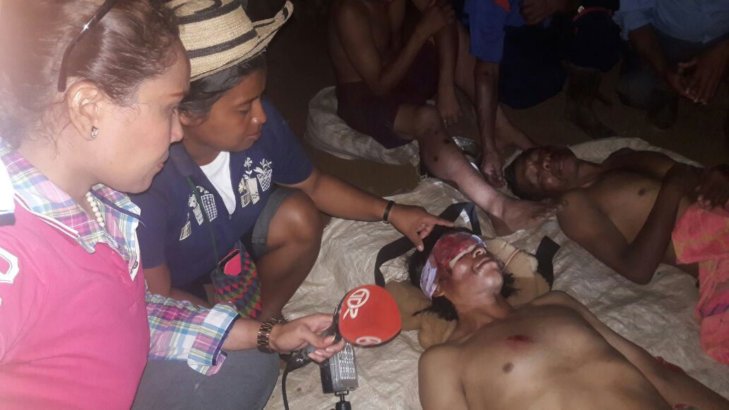
This photograph of journalist Lissette Centen at the scene verifies that the images were real. Credit: Frenadeso
According to a BARRO BLANCO. INFORME DDHH 22-6-16 (HRNP), the repression in Gualaquita is only the latest act of violence the Varela government has committed against Panama’s Indigenous Peoples.
According to eye-witness testimonies collected by the HRNP, on May 23, 2016, in an orchestrated prelude to the filling of the Barro Blanco reservoir, riot police descended on a Ngäbe protest camp, demolished a Mama Tata church and decapitated the community’s livestock. They rounded up some 30 protesters and held them for 36 hours without due process. Young children were among the detainees and one woman was apparently stripped naked in front of her family.
Despite clear threats to their safety, the Tabasará communities are determined to keep fighting Barro Blanco. Mass mobilizations are planned in different parts of the country for Monday September 5, 2016.
Meanwhile, the Ngäbe community of Kiad is at a critical juncture. According to Osvaldo Jordan, the waters of the reservoir are nearing the houses. “The main square can still be saved,” he said. The government just has to stop the flooding of Ngäbe land.

by Deep Green Resistance News Service | Jul 27, 2016 | Direct Action
By Will Falk / Deep Green Resistance
This year’s Fourth of July week grew in horror as it passed. Each day brought new nightmares that struck me at a dizzying pace. By the end of the week, after I decided I was sick of weeping, I turned off the television, shut my Facebook tab, and remembered that the best antidote for despair is action.
My week started hopefully enough in Eugene, Oregon where I participated in a training hosted by members of Deep Green Resistance called Extraction Resistance: A Three Day Training in Direct Action. One of the goals of the event was to normalize direct action tactics, and I was asked to write a primer on the topic. This is that primer.
When I got home from Eugene, I found a video news story from Karachi, Pakistan showing men digging mass graves in anticipation of the number of heat-related deaths caused by soaring summer temperatures. The ghosts of people not yet dead climbed from trenches dug in the dry Pakistani dust. I could almost see the bodies piling in the grave-diggers’ shadows.
The next day I watched as two white police officers pinned Alton Sterling, a black man, to the ground, put a pistol to his head, and shot him execution-style. I went to bed wondering how the cops were going to get out of this one only to wake to see Philando Castile slumped over in the seat of a car, blood seeping through his clothes, as his fiancé, Diamond Reynolds, explained in a video that Castile was just shot four times by a police officer in a routine traffic stop.
Then, during an otherwise peaceful rally protesting the murders of Sterling and Castile, twelve cops were shot, five of them fatally, and two civilians wounded by Micah Xavier Johnson, a military veteran who had served in Afghanistan. The Dallas Police Department then killed Johnson with a robot bomb.
Now, I am white, and I will not comment on the efficacy of Johnson’s actions. I will, however, direct a suggestion to white people who benefit from the white supremacism that the United States is founded upon and perpetuates. Let me suggest that the same culture producing climate change is the same culture producing the cops who murdered Sterling is the same culture producing the cops who murdered Castile is the same culture that trained Johnson “to shoot and move” is the same culture that employs police departments who possess robots with bombs that can be remotely controlled to kill citizens.
Let me suggest to those white people who are truly interested in undermining racism and stopping white supremacy that to do this we must dismantle the dominant culture. If we want to live in a world where Pakistanis are not digging mass graves for the victims of climate change, if we want to live in a world where people of color are not being murdered by cops, if we want to live in a world where veterans are not sniping from parking garages, if we want to live in a world where humans are not made into veterans in the first place, then we must look to the roots of the problem. Finding those roots, we must dig this poisoned tree out.
And, how do we dig these roots out? The answer begins with serious, militant resistance movements that correctly identify the dominant culture’s sources of power. Once those sources are identified, resistance movements must engage in direct action to undermine the dominant culture’s power.
***
First, we need to understand power. Quite simply, power is how the powerful do what they do. Power is how the cops murder and get away with it. Power is how corporations extract fossil fuels, burn fossil fuels, and drive the planet ever-closer to runaway climate change.
Power is best understood as a physical phenomenon. Power is not merely a mental event. Power is not simply an emotion. Cops may or may not personally hate the people of color they are murdering. Corporate decision makers may or may not personally despise the Earth that gives them life. What matters is that cops are armed with real batons, real pepper spray, real tasers, and real guns and they are supported by an entire governmental system that can protect them with even more batons, pepper spray, tasers, and guns. What matters is corporations are armed with real machines, real poisonous chemicals, real labor forces, and once their projects have been granted permits by the government, they can call on real cops with all the real weapons I’ve already described to protect their projects. What matters is physical power in the real world.
There is perhaps no person on Earth who has spent more time understanding the importance of power in contemporary politics than Gene Sharp. There is also perhaps no person in the world responsible for more successful revolutions than Sharp. This is no coincidence.
Sharp describes his theory of power in his brilliant book, How Non-Violent Struggle Works. His work helps us identify the dominant culture’s sources of power and provides insight into how those sources of power can be undermined.
Sharp begins by explaining the central importance of power, and writes: “Power is inherent in practically all social and political relationships. Its control is the basic problem in political theory and in political reality. It is necessary to wield power in order to control the power of threatening adversaries.” In short, the goal of any serious resistance movement should be to undermine the opposition’s power while enhancing the movement’s power.
Sharp defines political power as power “which is wielded for political objectives, especially by governmental institutions or by people in opposition to or in support of such institutions. Political power thus refers to the total authority, influence, pressure, and coercion which may be applied to achieve or prevent the implementation of the wishes of the power-holder.”
According to Sharp, the sources of political power are authority, human resources, skills and knowledge, intangible factors, material resources, and sanctions. These sources of power are interconnected and benefit and build off each other. Increasing power through one of these sources often enhances power in all the sources. This truth, while scary, also highlights weaknesses in the dominant culture’s power. If a resistance movement can undermine one source of power, it can deal a heavy blow to the others.
Sharp quotes Jacques Maritain to define authority as “the right to command and direct, to be heard or obeyed by others.” Taking this idea deeper than Sharp does, I want to point out that rights mean nothing if they are not enforceable. On the surface, it is easy to confuse the right to command and direct bestowed upon elected leaders, in the United States, as being derived from the results of an election. This is not completely true. Think, for example, what would happen if Barack Obama refused to yield the Oval Office to the winner of this year’s presidential election. Eventually, a governmental decision-maker would order police or soldiers to remove Obama at gunpoint.
Sharp describes how power is derived from human resources with, “The power of rulers is affected by the number of persons who obey them, cooperate with them, or provide them with special assistance.” These human resources come with the next source of power: skills and knowledge. Sharp writes, “The power of rulers is also affected by the skills, knowledge and abilities of such persons, and the relation of their skills, knowledge and abilities to the rulers’ needs.” Understanding this point, we see why the dominant culture is so obsessed with developing science and technology. It uses science and technology to enhance control. We see, too, why Western science has been a disaster for life.
Next, Sharp describes intangible factors as “Psychological and ideological factors, such as habits and attitudes toward obedience and submission, and the presence or absence of a common faith, ideology, or sense of mission.” To illustrate this point, imagine if rulers could convince people that this world isn’t real, that the sacred exists in an abstract sky God, and that the point of life is to suffer in this world to prove your devotion to this abstract sky God so you can join him, after death, in his abstract sky kingdom.
For material resources, Sharp writes, “The degree to which the rulers control property, natural resources, financial resources, the economic system, communication, and transportation helps to determine the limits of their power.”
To supplement Sharp’s analysis, here, we see one reason why the dominant culture is hell-bent on ecological destruction. Resource extraction yields power. Industrial agriculture – which requires the displacement of indigenous peoples, the extermination of animal populations, the theft of water from natural communities, deforestation, and the destruction of the world’s most important carbon sinks (grasslands) – yields a controllable food source. Mining – which also involves the displacement of indigenous peoples, the extermination of animal populations, the poisoning of groundwater, and mountain-top removal – yields energy sources for industrialization. And these are just two examples.
Sharp quotes John Austin to define sanctions as “an enforcement of obedience” and writes, “Sanctions are used by rulers to supplement voluntary acceptance of their authority and increase the degree of obedience to their commands…Violent domestic sanctions, such as imprisonment or execution, are commonly intended to punish disobedience, not to achieve the objective of the original command.”
We see, here, one of the primary roles of the police. Police exist to enforce obedience. Part of enforcing obedience is the performance of violent domestic sanctions like imprisonment and execution. To understand how this works think about a saying from the battered women’s movement: “One beating a year is enough to keep a woman down.” For a battered woman, it’s enough to keep her down that she merely be threatened with violence once she has experienced a man’s violence. The same is true for would-be resisters. After seeing videos of police murdering citizens, it only takes the threat of police violence to keep us in line.
***
Understanding that power is physical and identifying the material roots of the dominant culture’s power is only the first step. Now, we must act to physically dismantle those sources of power. Physically dismantling power requires direct action.
So, what is direct action?
The term “direct action” has been used so often within environmental and social movements in so many different contexts that it is in danger of losing its meaning. It is difficult to find a clear definition of direct action in activist literature rooted in a radical analysis, so I have formed my own. It has three parts: First, direct action involves a clearly defined and obtainable goal. Second, the success of that goal is demonstrable by a quantifiable reduction in the opposition’s physical power. Third, it is primarily the actions of those engaging in the direct action that produce the desired goal.
It is important that a proposed action begins with a clearly defined and obtainable goal because an action involving a poorly-defined goal makes it difficult to determine the scope of the action. And, proposed actions with unobtainable goals will be, by definition, ineffective. Planning to change the world through an educational program designed to illustrate the evils of the fossil fuel industry, for example, is neither clearly-defined nor obtainable. What does it mean “to change the world?” And, how will you possibly reach enough people to effect this change? Planning to delay the construction of a pipeline for a day, however, is both clearly-defined and obtainable. Resisters can, without too much imagination, envision a successful action.
Once a clearly-defined and obtainable goal is established, the direct action must reflect an understanding of power and be designed to materially affect the opposition’s physical power. Let’s say activists come up with a plan to drop a banner that says “Stop the Tarsands!” from the rafters of the Utah State Capitol. The plan is both clearly defined and, with some clever security dodging, obtainable. This action cannot be considered direct action, however, because there is no way to quantify how, or even if, the banner affects those in power’s ability to destroy.
Let’s look at another hypothetical plan: Activists plan to blockade, for 24 hours, trains carrying oil through the State of Washington where they will be loaded on to tankers to fuel the US Navy in Hawai’i. This plan has a clearly defined and obtainable goal. The goal also reflects an understanding of where the dominant culture gets its power. The US Navy, one of the weapons the United States uses to perpetuate imperialism, literally requires oil. Depriving the Navy of a little oil for one day may not be a big hit to its power, but it is quantifiable.
It is primarily the actions of those engaging in the direct action that produce the desired goal. Another way to say this is: There is a clear causal link between the direct action and the desired goal. If the goal is to block the construction of a pipeline, for example, then the planned action must literally stop the pipeline’s construction. If the goal is to liberate individual children from human trafficking networks, then the planned action must literally involve the means to escort children from human trafficking networks to safety. Yet another way to say this is: direct action does not leave it to external decision makers (governmental, corporate, or otherwise) to produce the desired goal. Direct action is not an appeal to those in power. It does not rely solely on moral persuasion, shame, or economic cost-benefit analyses.
A lawsuit, then, that is filed to gain protection for a species that lives on land where a mine is planned to be dug in order to stop the mine has a clearly defined and obtainable goal. If the lawsuit is won, then it will materially affect one of the dominant culture’s sources of power. But, this lawsuit is not direct action because it relies on a favorable ruling from a judge for its success. The actions of the lawsuit’s planners are necessary, but ultimately the planners themselves cannot produce the desired goal.
***
I’ve called this essay a “primer.” One definition of primer is “a short informative piece of writing.” Another is a “compound used to ignite an explosive charge.” I hope that this essay serves as both. We need to see the problems we face clearly and we need a spark to ignite the change that is so drastically needed.
by Deep Green Resistance News Service | Jan 30, 2016 | Building Alternatives, Repression at Home, Toxification
Originally published in the September/October 2012 issue of Orion. Now republished for the first time online.
In an era of government-sanctioned polluters, communities must defend themselves
Several years ago I spoke at a benefit for an organization working to prevent a toxic waste site from being built in their community. Yet another toxic waste site, the organizers clarified, since there already was one. It should surprise no one that their community was primarily poor, primarily people of color, and that the toxic waste was being brought in so that distant corporations could reap bigger profits.
The organization had been fighting the dump for years, on every level, from filing lawsuits to holding protests to physically blockading the dump site. Several people at the benefit commented on the bizarre role that the police played in all of this. Many of the cops lived in the community and were themselves opposed to the toxic dump. But when they put on their uniforms and headed off to work, their jobs included arresting their neighbors who were trying to protect the neighborhoods where their own children lived and played.
We’ve all heard of dues-paying union cops busting the heads of strikers because their capitalist bosses tell them to. And of cops arresting protesters trying to prevent the cops’ own water supplies from being toxified (while of course not arresting the capitalists who are toxifying the water supplies). And I’m sure I’m not the only one who’s had fantasies that at the next economic summit or World Bank meeting, members of the police will experience an epiphany of conscience and realize they share class interests not with those they’re protecting but rather with those at whom they’re pointing their guns. And in this fantasy the police then turn as one to join the protesters and face their real enemy.
At the benefit we shared all sorts of fantasies like these, and we all laughed at how unrealistic they were. There have been instances in which the police have worked with the people to stop government or corporate atrocities, but they’re too rare.
And then we shared some other fantasies, which all consisted in one way or another of police choosing to enforce laws that are already on the books, laws that protect our communities. Laws like the Clean Air Act, or the Clean Water Act, or for that matter laws against rape. We fantasized about what it might be like to have police enforce carcinogen-free zones, or dam-free zones, or WalMart-free zones, or rape-free zones.
And then again we laughed, since we knew that these fantasies, too, were unrealistic. It’s not the job of the police to protect you from living in a toxified landscape, even if that landscape is being toxified illegally.
In fact — and this may or may not be surprising to you — the police are under no legal obligation to protect you at all. This fact has been upheld in courts again and again. In one case, two women in Washington DC were upstairs in their townhouse when they heard their roommate being assaulted downstairs. Several times they phoned 911 and each time were told police were on their way. A half hour later their roommate stopped screaming, and, assuming the police had arrived, they went downstairs. But the police hadn’t arrived, and so for the next fourteen hours all three women were repeatedly beaten and raped. The women sued the District of Columbia and the police for failing to protect them, but the district’s highest court ruled against them, saying that it is “a fundamental principle of American law that a government and its agents are under no general duty to provide public services, such as police protection, to any individual citizen.”
So there you have it. Time and again, many similar cases have yielded the same case law, at local, state, and federal levels. But a lot of rape victims already know this; only 6 percent of rapists spend even one night in jail. And the people in that community who were having a toxic waste dump crammed down their throats with the professional support of the police also know this. As do the human and nonhuman people of the Gulf of Mexico, who are still being killed or injured by the Deepwater catastrophe — and who will experience far more of the same, since the U.S. government is supporting more deepwater drilling. As one technical advisor to the oil and gas industry put it, “We are seeing deep-water drilling coming back with a vengeance in the Gulf.”
So here’s the question: if the police are not legally obligated to protect us and our communities — or if the police are failing to do so, or if it is not even their job to do so — then if we and our communities are to be protected, who, precisely is going to do it? To whom does that responsibility fall? I think we all know the answer to that one.
A lot of people seem to love to talk about the virtues of self- and community-reliance, but where are they when we need to defend our communities?
Fortunately there are many examples of communities rising up to defend themselves from wrongdoing from which we can and should learn. Pre-Revolutionary — or you could say revolutionary yet pre-1776 — American patriots, sick and tired of rule by a distant elite (sound familiar?), increasingly refused to acknowledge the legitimacy of the Crown Courts and other institutions, and put in place their own systems of justice. The same has been true for the Irish in their struggle for independence. The same was true of the Spanish anarchists: part of their project included pushing fascists out of their communities and another part consisted of putting in place their own neighborhood systems of justice and community protection.
I think often of something a former head of “security” for South Africa under apartheid said: that what they’d been most afraid of from the revolutionary group the African National Congress had never been the ANC’s sabotage or even their violence, but rather that the ANC might be able to convince the mass of South Africans to not believe in law and order as such, which in this case meant the law and order imposed by the apartheid regime, which in this case meant the legitimacy of the exploitative apartheid government, which in this case meant that their greatest fear was that the ANC would convince the majority of people to withdraw their consent to be governed by an elite that does not have their best interests at heart.
In our case, we don’t need an ANC to convince us of the illegitimacy of many of the actions of those in power. Those in power are doing a great job of convincing us by their own actions. If the Gulf catastrophe (and the continuation of deepwater drilling) doesn’t convince you, I don’t know what will. If fracking and the poisoning of our groundwater doesn’t convince you, I don’t know what will. If the governmental response to global warming — ranging from vindictiveness against climate scientists to denial to measures that at very best are completely incommensurate with the threat — doesn’t convince you, I don’t know what will. If the total toxification of the environment, with its inevitable health consequences for both humans and nonhumans, doesn’t convince you, I don’t know what will. I routinely ask the people at my talks whether they have had someone they love die of cancer, and at least 75 percent almost always say yes.
And when I ask people at my talks if they believe that state and federal governments take better care of corporations or of human beings, no one — and I mean no one — ever says human beings. Reframing the question to consider whether governments take better care of corporations or the planet — our only home — yields the same result.
If police are the servants of governments, and if governments protect corporations better than they do human beings (and far better than they do the planet), then clearly it falls to us to protect our communities and the landbases on which we in our communities personally and collectively depend. What would it look like if we created our own community groups and systems of justice to stop the murder of our landbases and the total toxification of our environment? It would look a little bit like precisely the sort of revolution we need if we are to survive. It would look like our only hope.
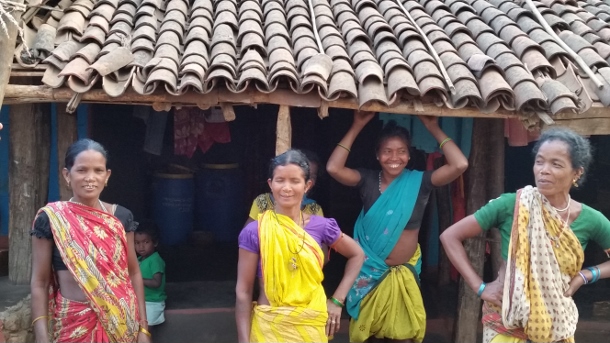
by DGR Colorado Plateau | Nov 7, 2015 | Colonialism & Conquest, Human Supremacy, Indigenous Autonomy, Indirect Action
In early October, news emerged that India’s Ministry of Environment, Forest and Climate Change was blocking the implementation of a high-level government panel’s report on tribal rights that recommended the creation of stringent rules to safeguard indigenous people from displacement. Meanwhile, two state governments have begun implementing a much different set of guidelines — issued in August without any interference — that allow the private sector to manage 40 percent of forests for profit at the expense of indigenous forest dwellers. In addition, another ordinance passed this year will permit private corporations to easily acquire land and forests from indigenous communities and carry out ecologically harmful mining. These legislative and policy decisions are usually made without the knowledge of indigenous communities whose lives, livelihoods and ecosystems will be worsened by these irresponsible actions of the government. Hence, indigenous communities in Uttar Pradesh, a northern state and Odisha, in the east, are strengthening their organizing to protect their rivers, lands, forests and hills from “development” that would displace thousands of local residents and destroy the environment.“People from my community and I were beaten, detained or jailed unnecessarily for opposing tree felling in our forests, some years ago,” said Nivada Debi, a feisty 38-year-old woman from the Tharu Adivasi community in Uttar Pradesh. “We visited the police station multiple times for their release. The government did not assist the injured. Despite the police and government indifference, we will fight for our land and environment.”A mother of four children subsisting on the forests, Debi is active in grassroots resistance that started nearly 20 years ago and has grown into the All India Union of Forest Working People, or AIUFWP. The group is made up of many indigenous people who subsist on forests and are collectively protecting forests from poachers and encroachers.
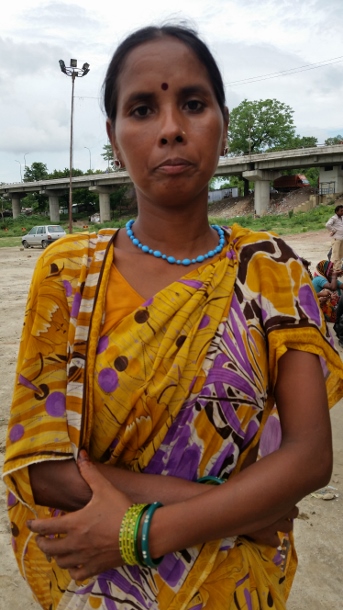
Debi was among hundreds — from the AIUFWP, the allied Save Kanhar Movement and other resistance groups — who traveled to Lucknow in July 2015 for a rally protesting the continued incarceration of their comrades fighting land grabbing in other districts of Uttar Pradesh. Roma Malik, the AIUFWP deputy general secretary, and Sukalo Gond, an Adivasi, which means original inhabitant, were among those arrested on June 30, before they were to address a large public gathering about the illegal land acquisition for the Kanhar dam and the violent repression of its opponents by the state. Another member of AIUFWP, Rajkumari, who prefers to go by her first name, was jailed on April 21, after 39 Adivasis and Dalits, who are considered outside the caste hierarchy, were brutally shot at by the police during a peaceful protest on April 18. The demonstration, which began on April 14 — the birthday of B.R. Ambedkar, the architect of the Indian constitution and an icon for many Indians, particularly Dalits — was opposing the construction of a dam across the Kanhar river in the Sonbhadra district of southeastern Uttar Pradesh.
Rajkumari was released toward the end of July while Gond and Malik were freed in September. However, others are still imprisoned on fabricated charges. Courts are delaying hearing their cases or denying them bail.
AIUFWP members, some of whom were previously involved with other local resistance movements, have been actively opposing the construction of the Kanhar dam for years. It would submerge over 10,000 acres of land from more than 110 villages in Uttar Pradesh and the neighboring states of Chattisgarh and Jharkhand, displacing thousands of local people and disrupting their lives and livelihoods. The dam was approved by the Central Water Commission of India in 1976, but was abandoned in 1989 after facing fierce opposition, especially from the local people whose lives and ecosystem would be destroyed by the proposed dam. However, construction resumed in December 2014, violating orders to stop it from the National Green Tribunal — a government body that adjudicates on environmental protection, forest conservation and natural resource disputes. No social impact assessment was done, nor were the necessary environmental or forest clearances — mandated by the Forest Conservation Act — obtained by the state government.
“Since this dam can destroy our survival and also adversely impact the surroundings, we have been opposing its construction and related land acquisition for many years,” said Shobha, a determined 42-year-old Dalit. “On December 23, 2014, the police caned some of our comrades when we were peacefully protesting the revival of building the dam earlier that month. However, the police falsely accused some leaders of our struggle of attacking the sub-divisional magistrate.” Shobha, who also prefers to go only by her first name, is among the vocal leaders of a women’s agricultural laborers union, which has allied with AIUFWP, in the village of Bada.
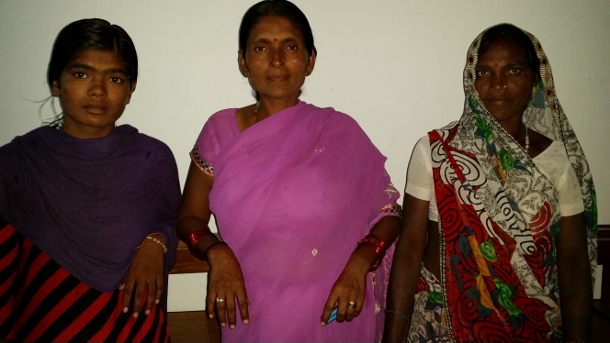
Around 400 miles from Sonbhadra, in the Kalahandi and Rayagada districts of southern Odisha, live the Dongria Kondhs, an indigenous community of over 8,000 people. They have been fighting tirelessly to protect their sacred mountain, the nearly 5,000-foot high Niyamgiri, from large private corporations — like Vedanta Limited — that are trying to mine bauxite in the area to produce aluminum. Supporters of the Dongria Kondhs were arrested in Delhi on August 9 outside the Reserve Bank of India, as they peacefully highlighted Vedanta’s illegitimate and harmful mining in the Niyamgiri. Vedanta’s mining would violate the Forest Rights Act, which states that indigenous communities are entitled to remain in the forests — and utilize the produce, land and water in the forests — while conserving and protecting them.
“The Niyamgiri symbolizes a parent to our community,” said Sadai Huika, a steadfast 45-year-old Dongria Kondh woman from Tikoripada village. “While the streams that originate from it help our farming, the plants and grass that grows on it feed our cattle and goats. We cannot exist without it and will safeguard it from anyone trying to harm it.”
Huika and people from hundreds of villages near the Niyamgiri are active members of the Niyamgiri Protection Forum, which originated around 2003 to resist attempts by Vedanta to begin mining where the Kondhs live, with the support of the Odisha state government. At every one of the 12 village council meetings with government officers held in 2013 atop the Niyamgari, community members stated that they would not allow mining nearby.
Kumuti Majhi, an elderly Dongria Kondh man and one of the forum’s leaders, is among the few people who have traveled within and outside Odisha to advocate against mining and garner vital support for their struggle. He has met ministers to explain how significant the Niyamgiri is to his community and their reasons for safeguarding it.
By organizing protests locally and with allies around the world — and meetings with Vedanta’s shareholders and empathetic government officials, who the forum has enlightened about the need to protect the Niyamgiri — the group has stalled the mining.
“We know that extracting bauxite from the Niyamgiri will pollute our environment and also affect all living beings here,” Majhi said. “Hence, we will stop anyone coming to plunder the Niyamgiri, despite police harassment and false charges against us and our families.”
Pushpa Achanta is a Bangalore-based freelance journalist, blogger and writer on development and human interest issues. She is the lead author of a book titled Ripples: The Right to Water and Sanitation for Whom, published in July 2013 by the Indian Social Institute in Bangalore. Her articles have appeared in collections of essays and features on different subjects. She also enjoys penning verse, taking nature photography and mentoring youth.
















